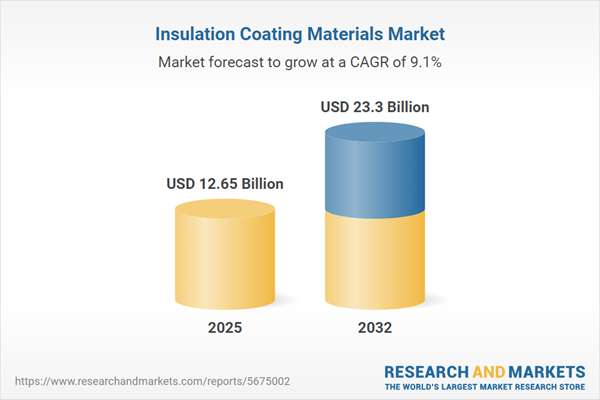Speak directly to the analyst to clarify any post sales queries you may have.
The insulation coating materials market is adapting quickly to new operational demands as businesses focus on resilience, sustainability, and compliance. Organizations are leveraging a range of advanced coatings to protect assets, support regulatory adherence, and address emerging industry mandates.
Market Snapshot: Insulation Coating Materials Market Size and Growth
In 2024, the insulation coating materials market reached a value of USD 11.56 billion, with projections indicating growth to USD 12.65 billion in 2025 and further expansion to USD 23.30 billion by 2032 at a CAGR of 9.14%. This momentum reflects widespread adoption across multiple industries prioritizing energy savings and risk mitigation through high-performance coatings. Organizations in construction, oil and gas, automotive, aerospace, and marine are aligning coating investments with sustainability initiatives, asset life extension, and regulatory compliance. Leadership teams are focusing on integrated innovation, elevating the importance of product advancements in environmental stewardship and efficient operations.
Scope & Segmentation of the Insulation Coating Materials Market
- Material Types: Acrylics provide adaptability for diverse use cases. Epoxies offer strong chemical and abrasion resistance, while polyurethanes deliver tailored performance for specific environments, and silicones guarantee thermal stability in high-temperature settings.
- Coating Bases: Powder, solvent-based, and water-based formats cater to unique operational requirements. The shift toward powder and water-based options reflects both sustainability objectives and increasing regulatory scrutiny.
- End Use Industries: Construction, aerospace, automotive, marine, oil and gas, and heavy industry rely on these coatings to reinforce compliance, increase equipment uptime, and extend asset longevity.
- Application Areas: Solutions target corrosion resistance, fire protection, thermal management, and preservation of key infrastructure, supporting proactive risk reduction.
- Form Factors: Liquid concentrates, ready-to-use products, and powder forms accommodate flexible deployment across supply chains and varying production environments.
- Technology Platforms: Traditional coating technologies intersect with emerging nanocoatings and smart coatings, introducing predictive maintenance and self-repair features into the asset management landscape.
- Regional Coverage: The market demonstrates distinct patterns across North America, Latin America, Europe, the Middle East, Africa, and Asia-Pacific. Asia-Pacific leads in technology adoption, while Western markets emphasize sustainable solutions and product life cycle management.
- Company Developments: Leading companies—including PPG Industries, Sherwin-Williams, Akzo Nobel N.V., Nippon Paint, Kansai Paint, Axalta, RPM International, Jotun, BASF, and Hempel—are continuously realigning portfolios with shifts in industry standards and region-specific requirements.
Key Takeaways: Strategic Insights for Senior Decision-Makers
- Smart coating technologies such as nanocoatings enable organizations to anticipate maintenance needs, reducing unscheduled downtime and expanding asset protection cycles.
- Strengthening supplier relationships and pursuing diverse sourcing improve resilience to fluctuating trade policies and evolving compliance demands.
- The adoption of sustainable options like powder and water-based coatings enhances environmental credibility while supporting organizational agility.
- Implementation of digital tools—from simulation to advanced analytics—drives operational efficiencies and comprehensive oversight in complex asset portfolios.
- Strategically selected materials, including epoxies for chemical resilience or silicones for high-heat environments, optimize both compliance and asset performance.
- Staying responsive to new regulations across global markets supports expansion initiatives and decreases compliance risks in changing environments.
Tariff Impact: Navigating Trade and Supply Chain Pressures
Recent tariffs on insulation coating materials, particularly in the United States, have prompted companies to strengthen supplier networks and reinforce logistics infrastructure. Organizations are prioritizing nearshoring and strategic procurement to sustain supply continuity and balance trade risk.
Methodology & Data Sources
Findings rely on direct input from executive interviews, regulatory analysis, review of academic studies, patent investigations, and laboratory assessments. This methodology ensures balanced, actionable, and reliable insulation coating materials market insights for strategic decision-making.
Why This Report Matters: Actionable Market Intelligence
- Enables leadership teams to forecast market changes accurately and integrate regulatory or sustainability mandates with ongoing operations.
- Supports effective adoption of new coating technologies for improved asset life cycle management and compliance across demanding production settings.
- Guides proactive risk management, allowing organizations to navigate shifting supply dynamics and seize opportunities for operational improvement.
Conclusion
Strategic choices in insulation coating materials bolster business resilience and adaptability amid evolving compliance and sustainability landscapes. Focusing on technology and procurement ensures sustained operational strength as industry challenges intensify.
Additional Product Information:
- Purchase of this report includes 1 year online access with quarterly updates.
- This report can be updated on request. Please contact our Customer Experience team using the Ask a Question widget on our website.
Table of Contents
3. Executive Summary
4. Market Overview
7. Cumulative Impact of Artificial Intelligence 2025
Companies Mentioned
The companies profiled in this Insulation Coating Materials market report include:- PPG Industries, Inc.
- The Sherwin-Williams Company
- Akzo Nobel N.V.
- Nippon Paint Holdings Co., Ltd.
- Kansai Paint Co., Ltd.
- Axalta Coating Systems Ltd.
- RPM International Inc.
- Jotun A/S
- BASF SE
- Hempel A/S
Table Information
| Report Attribute | Details |
|---|---|
| No. of Pages | 196 |
| Published | October 2025 |
| Forecast Period | 2025 - 2032 |
| Estimated Market Value ( USD | $ 12.65 Billion |
| Forecasted Market Value ( USD | $ 23.3 Billion |
| Compound Annual Growth Rate | 9.1% |
| Regions Covered | Global |
| No. of Companies Mentioned | 11 |









